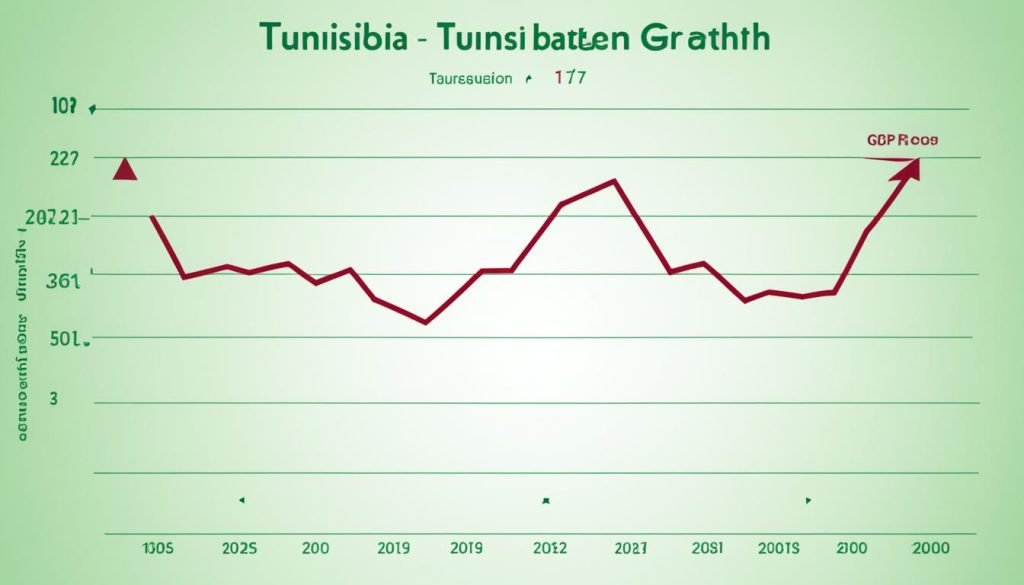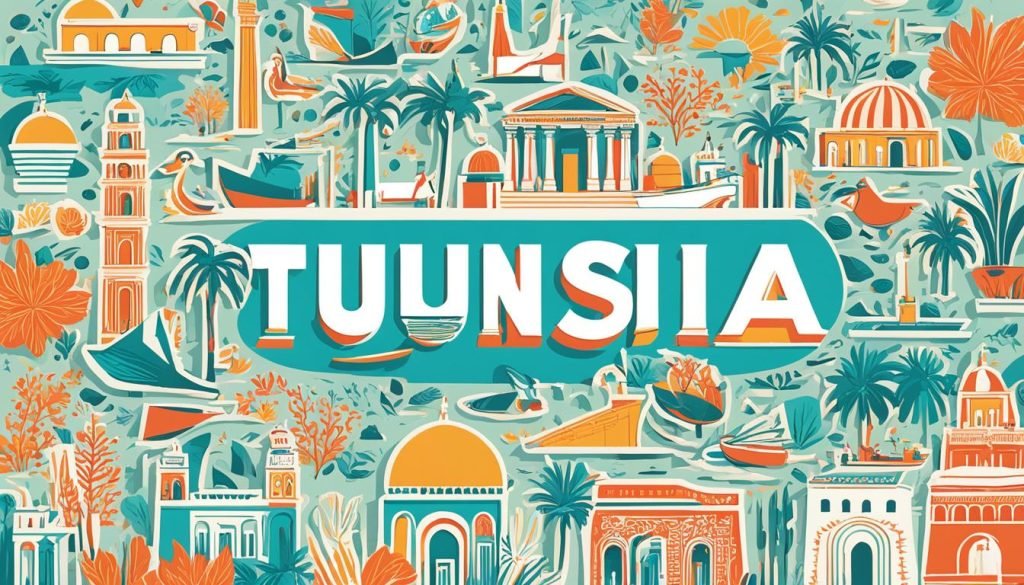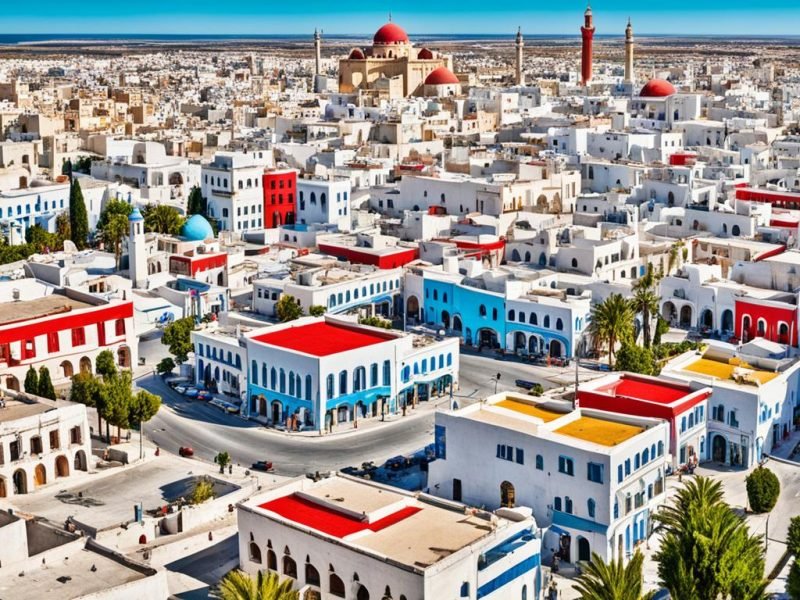Tunisia is at a turning point in its economy. The World Bank sees a lot of potential with the new Country Partnership Framework. It matches Tunisia’s development goals and the Tunisie 2035 vision. This plan focuses on creating jobs, saving energy, and improving schools. These steps can make Tunisia’s economy stronger.
The country is working on important areas like green energy and helping small businesses. With up to $500 million a year and help from big partners, Tunisia is ready to grow. We will look closely at this progress. It shows us the positive changes in Tunisia’s economy.
Key Takeaways
- The World Bank’s new Country Partnership Framework aligns with Tunisia’s strategic development plans.
- Focus on private sector-led job creation fosters a positive Tunisia economic outlook.
- Reform efforts are underpinned by gender integration and social accountability.
- Access to finance for SMEs is crucial for Tunisia’s economic development and resilience.
- Substantial international support and partnerships bolster the positive trends in Tunisia’s economy.
Tunisia’s Economic Overview and Challenges
Tunisia is moving from a state-run to a market-driven economy. This change is interesting to study. The country is growing but also facing issues.
Striving Beyond State Direction Towards Market Liberalization
Tunisia is working to reduce state control. It wants the market to have more influence. This effort is supported by reforms and policies. They aim to improve the economy and make it stable. Things like the EU Association Agreement and privatizing companies are key.
Historical Economic Patterns and Diversification Efforts
Tunisia has depended on tourism, farming, and making things. Now, it’s trying to vary its economy. New industries are growing. This makes the economy stronger and less risky.
Resilience and Recovery Post-Arab Spring
After the Arab Spring, Tunisia’s economy was tested. There was a lot of political trouble. But, the economy is getting better. Tunisia is working hard to grow its economy and keep it stable.
Still, Tunisia has big challenges like high unemployment among young people. To fix this, it needs ongoing work and changes. This will help everyone in the economy.
| Year | Unemployment Rate | GDP Growth |
|---|---|---|
| 2015 | 15% | 1.2% |
| 2019 | 15.1% | 2.0% |
| 2021 | 17.4% | -8.2% |
| 2022 | 16.2% | 3.8% |
Tunisia must keep focusing on opening its economy, trying new things, and keeping it stable. This is how it will keep getting better.
Assessing Tunisia’s GDP and Economic Growth
Looking at Tunisia’s economy, I focus on its Tunisian GDP growth and overall economic performance. Tunisia’s GDP for 2024 is guessed to be $53.482 billion. Its purchasing power is about $178.928 billion. These figures show the nation’s wealth and how it deals with economic ups and downs.
We will compare some major economic numbers to see how Tunisia’s economy is doing:
| Indicator | 2022 | 2023 Estimate | 2024 Projection |
|---|---|---|---|
| GDP (Nominal) | $50.856 billion | $52.340 billion | $53.482 billion |
| GDP (PPP) | $175.103 billion | $176.885 billion | $178.928 billion |
| GDP Per Capita (Nominal) | $3,985 | $4,060 | $4,136 |
| GDP Per Capita (PPP) | $13,655 | $13,899 | $14,294 |
| Inflation Rate | 6.53% | 6.2% | 6.0% |
| Unemployment Rate | 15.3% | 14.8% | 14.4% |
The jobless rate is still a big issue. Yet, we saw a Tunisian GDP growth of 4.2% in 2021. This shows a mix of high and low economic moments. Efforts to make the economy more diverse have been key since the 1990s.

This detailed look shows Tunisia’s global economic rank. By 2024, it will be 92nd in nominal terms and 81st in PPP. Understanding the Tunisian economy means looking at both outside and inside factors.
The Pillars of Stability in Tunisian Economy
In discussing Tunisia’s economic stability, it’s important to look at its key strengths. These include foreign investments and a focus on exports. Together, they help Tunisia grow and remain resilient.
Foreign Investment and Export-Oriented Growth
Tunisia’s economy thrives on welcoming foreign investments and pushing for exports. The Tunisian investment code plays a big role. It attracts global capital. Also, improvements to the Bourse de Tunis make Tunisia more inviting to investors. This helps Tunisia’s position in North African markets.
Reform Programs and International Partnerships
International partnerships support Tunisia’s economic reforms. A key partnership is with the European Union. This helps Tunisia tap into larger markets. It makes its export strategies stronger. These efforts are changing Tunisia’s economy for the better.
Private Sector Initiatives and Technological Innovation
The private sector in Tunisia is embracing technology and innovation. The push for privatizations since 1987 has been game-changing. It leads to a more tech-savvy market. This not only boosts competitiveness but also makes the economy more diverse and resilient.
| Indicator | 2018 | 2023 |
|---|---|---|
| FDI Net Inflows (% of GDP) | 2.1% | 3.5% |
| Exports (% of GDP) | 40.3% | 44.2% |
| Technology Exports (% of Manufactured Exports) | 5% | 8.5% |
This table shows Tunisia’s progress in attracting investments and boosting exports. The focus on high-value exports is improving Tunisia’s economic standing. These efforts are key to its ongoing growth and stability.
Inflation, Employment, and the Cost of Living in Tunisia
Looking into Tunisia Economic Trends shows us how inflation and job issues impact life. As of the second quarter of 2022, Tunisia’s inflation rate was about 6.53%. This high rate makes living in Tunisia more expensive.
The jobless rate is around 15.3%, showing that finding work is tough. This affects families across Tunisia.
In 2023, the average monthly pay is $360. This number helps us understand what life is like in Tunisia. It shows how people manage their daily expenses.
About 15.2% of Tunisians lived in poverty in 2015. This info helps us see the economic challenges they face.
In 2015, the Gini coefficient was at a medium level. This means income is not evenly distributed. Such differences can lead to tensions in society. These facts together paint a picture of an economy trying to improve.
| Year | Inflation Rate (%) | Unemployment Rate (%) | Average Net Salary (USD) | Population Below Poverty Line (%) |
|---|---|---|---|---|
| 2015 | 5.5 | 15.2 | 350 | 15.2 |
| 2022 | 6.53 | 15.3 | 360 | Projected similar |
Tunisia Economic Performance Indicators
Exploring the Tunisian Economic Indicators helps us get the financial picture of Tunisia. The nation’s Human Development Index was 0.731 in 2021. This shows strong growth despite hurdles. The labor force data highlights a focus on industry and services, at 33.2% and 51.7% respectively.
The government’s economic strategy shows a balance. It aims for stability and growth in Tunisia’s outlook. The government debt was 70.3% of GDP in 2017. There was also a budget deficit of 5.8% of GDP. These figures highlight steps needed for economic stability.
- Human Development Index (HDI): 0.731 in 2021
- Labor Force Participation – Industry: 33.2%
- Labor Force Participation – Services: 51.7%
- Government Debt as % of GDP: 70.3% in 2017
- Budget Deficit as % of GDP: 5.8% in 2017
- Foreign Reserves: $8.5 billion as of December 23, 2023
This in-depth look at the Tunisian Economic Indicators helps us understand its successes and hurdles. With smart economic decisions, Tunisia aims to improve despite fiscal pressures.
Tunisia’s Investment Climate and Opportunities
Exploring Tunisia’s investment climate shows a plan to attract investors. Tunisia is fostering an area full of chances for different economic roles. This is with progressive policies and support.
Government Incentives for Businesses
Tunisia is working hard to make its Tunisia Investment Climate better. This is with tax cuts and help aimed at supporting the financial market. It makes doing business easier. This move seeks to boost Tunisia Economic Development and ensure long-term growth.
Sector-Specific Growth Potential
Tunisia’s main sectors like petroleum and tourism show strong growth. Each sector has special investment and growth chances. This growth is supported by government initiatives, aiming for widespread wealth.
The Role of SMEs in Economic Development
SMEs play a key role in Tunisia’s economy. They help in the country’s recovery and ongoing wealth. Government and international aid help them get loans and reduce financial issues. This helps SMEs grow and strongly aid in Tunisia Economic Development.

Conclusion
Tunisia’s economic journey is full of ups and downs. It shows strong efforts towards a stable economy. The Country Partnership Framework helps make growth inclusive and sustainable. By improving education and creating strong jobs, Tunisia builds a lasting economy.
The country is in a key economic spot. It can grow with the help of outside partners and investment. But, challenges like high prices, joblessness, and money issues still exist. Tunisia bravely faces these problems, hoping for a better future.
When thinking about Tunisia’s economy, there’s a mix of chances and challenges. With smart plans and global thinking, Tunisia can thrive. Combining local work and global help will lead Tunisia to prosperity and stability.







